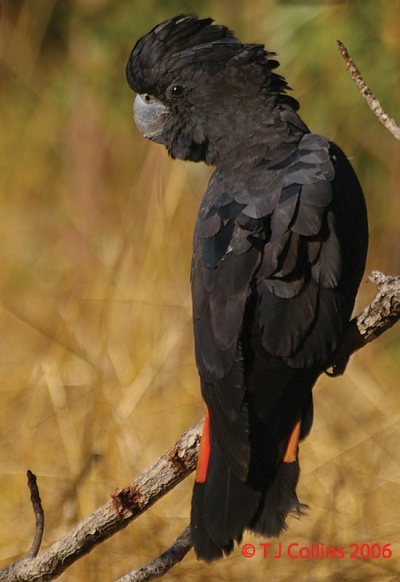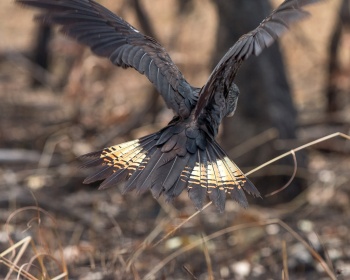- Calyptorhynchus banksii
Identification
50–65 cm (19¾-25½ in)
- Black overall plumage
- Red tail bands
Females
- Brownish-black overall plumage
- Yellow bars and spots
- Yellowish-orange tail stripes
Distribution
Australia: found in New South Wales, Northern Territory, Queensland, South Australia, Victoria, Western Australia
Taxonomy
Subspecies
There are 5 subspecies[1]:
- C. b. naso:
- Forests of south-western Western Australia
- C. b. escondidus:
- Western Australia (arid and semi-arid zones of Western Australia south of the Kimberley)
- C. b. banksii:
- Tropical northern Australia (northeastern Western Australia east to eastern Queensland and northeastern New South Wales)
- C. b. samueli:
- central Australia (southern Northern Territory, northern South Australia, southwestern Queensland, and central New South Wales)
- C. b. graptogyne:
- Forests of south-eastern South Australia and south-western Victoria
Habitat
Tropical forests; eucalyptus woodlands near water, shrub and grassland.
Behaviour
Diet
Their diet consists of a variety of eucalyptus seeds, berries, fruits, insects and grubs.
Breeding
They build their nests in large, vertical tree cavities. The clutch consists of 1 to 2 white eggs, however usually only 1 survives to fledging.
References
- Clements, J. F., T. S. Schulenberg, M. J. Iliff, S. M. Billerman, T. A. Fredericks, J. A. Gerbracht, D. Lepage, B. L. Sullivan, and C. L. Wood. 2021. The eBird/Clements checklist of Birds of the World: v2021. Downloaded from https://www.birds.cornell.edu/clementschecklist/download/
- Avibase
- Handbook of the Birds of the World Alive (retrieved June 2015)
- Wikipedia
Recommended Citation
- BirdForum Opus contributors. (2025) Red-tailed Black Cockatoo. In: BirdForum, the forum for wild birds and birding. Retrieved 19 April 2025 from https://www.birdforum.net/opus/Red-tailed_Black_Cockatoo
External Links
GSearch checked for 2020 platform.1







